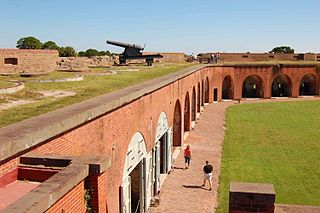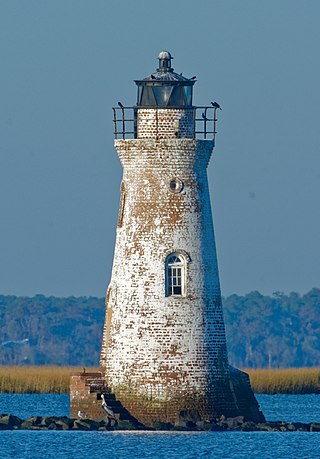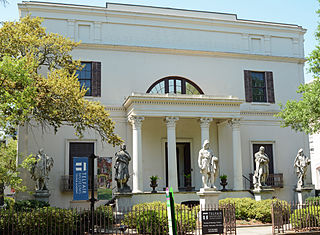
Savannah is the oldest city in the U.S. state of Georgia and is the county seat of Chatham County. Established in 1733 on the Savannah River, the city of Savannah became the British colonial capital of the Province of Georgia and later the first state capital of Georgia. A strategic port city in the American Revolution and during the American Civil War, Savannah is today an industrial center and an important Atlantic seaport. It is Georgia's fifth most populous city, with a 2020 U.S. Census population of 147,780. The Savannah metropolitan area, Georgia's third-largest, had a 2020 population of 404,798.

Bryan County is a county located in the U.S. state of Georgia. As of the 2020 census, the population was 44,738. The county seat is Pembroke.

Richmond Hill is a city in Bryan County, Georgia, United States. The population was 16,633 at the 2020 U.S. Census, an increase of almost 80% from the 2010 population of 9,281. Richmond Hill is part of the Savannah Metropolitan Statistical Area.

Darien is a city in and the county seat of McIntosh County, Georgia, United States. It lies on Georgia's coast at the mouth of the Altamaha River, approximately 50 miles south of Savannah, and is part of the Brunswick, Georgia Metropolitan Statistical Area. It is the second oldest planned city in Georgia and was originally called New Inverness. The population of Darien was 1,460 at the 2020 census, down from 1,975 in 2010.

Fort McAllister was a Confederate earthen-work fort used to defend Savannah, Georgia during the American Civil War. It was the southernmost of the forts defending Savannah and was involved in the most battles. It was located on the Ogeechee River in Bryan County. It is listed on the National Register of Historic Places (#70000197). Fort McAllister was one of three forts protecting Savannah, the others being Fort Pulaski and Fort James Jackson standing in Confederate defiance of the Union naval blockade. The southeast coast of the United States was the place where both combatants tested the latest in naval artillery and coastal defenses. Fort McAllister was the key to unlocking the defenses around Savannah, one of the most important Confederate ports on the Atlantic Ocean.

Fort Frederica National Monument, on St. Simons Island, Georgia, preserves the archaeological remnants of a fort and town built by James Oglethorpe between 1736 and 1748 to protect the southern boundary of the British colony of Georgia from Spanish raids. About 630 British troops were stationed at the fort.

Fort Pulaski National Monument is located on Cockspur Island between Savannah and Tybee Island, Georgia. It preserves Fort Pulaski, the place where the Union Army successfully tested rifled cannon in combat during the American Civil War in 1862, the success of which rendered brick fortifications obsolete. The fort was also used as a prisoner-of-war camp.

Keller is a small unincorporated community located in southern Bryan County, Georgia, United States, east of Richmond Hill. Its boundaries are ill-defined, but the community could be said to be centered on the intersection of S.R. 144 and Belfast-Keller Road. Currently the area, like most of South Bryan, is an unincorporated community of extensive residential development with a number of planned neighborhoods. However, Keller also has a significant historical aspect. It is near Fort McAllister Historic Park, an earthen Civil War installation captured by General William Sherman on his March to the Sea. Bryan Neck Presbyterian Church, established in 1839 and rebuilt in 1885, is listed on the National Register of Historic Places, and is located on Belfast-Keller Road about a mile from the S.R. 144 intersection. A number of antebellum plantation houses or sites exist along the marshes and waterfront areas of extreme south Bryan County, though none are in public hands or are preserved as historic sites.

Waynesboro is a city in Burke County, Georgia, United States. The population was 5,766 at the 2010 census. The city is the county seat of Burke County. It is part of the Augusta, Georgia metropolitan area.

Fort McIntosh was an early American log frontier fort situated near the confluence of the Ohio River and the Beaver River in what is now Beaver, Pennsylvania.

The Cockspur Island Light is the smallest lighthouse in Georgia. It ceased operation as an active beacon in 1909. It has been relit since 2007 for historical rather than navigational purposes.

The Battle of Brier Creek was an American Revolutionary War battle fought on March 3, 1779, near the confluence of Brier Creek with the Savannah River in eastern Georgia. A mixed Patriot force consisting principally of militia from North Carolina and Georgia along with some Continental regulars was defeated, suffering significant casualties. The rout damaged Patriot morale.

The Green–Meldrim House is a historic house at 14 West Macon Street, on the northwest corner of Madison Square, in Savannah, Georgia. Built in 1853, it was designated as a National Historic Landmark in 1976 as one of the American South's finest and most lavish examples of Gothic Revival architecture. The house is owned by the adjacent St. John's Episcopal Church, which offers tours and uses it as a meeting and reception space.

William Scarbrough House is a historic house in Savannah, Georgia. Built in 1819, and subjected to a number later alterations, it is nationally significant as an early example of Greek Revival architecture, and is one of the few surviving American works of architect William Jay. The house was declared a National Historic Landmark in 1973. It is now home to the Ships of the Sea Maritime Museum, and it has largely been restored to an early 19th-century appearance.

The Telfair Academy is a historic mansion at 121 Barnard Street in Savannah, Georgia. It was designed by William Jay and built in 1818, and is one of a small number of Jay's surviving works. It is one of three sites owned by Telfair Museums. Originally a family townhouse belonging to the Telfair family, it became a free art museum in 1886, and thus one of the first 10 art museums in America, and the oldest public art museum in the South. Its first director, elected in 1883, was artist Carl Ludwig Brandt, who spent winters in Savannah. It was declared a National Historic Landmark in 1976.

The historic Savannah–Ogeechee Barge Canal is one of the prime relics in the history of southern canals. Beginning with the tidal lock at the Savannah River, the waterway continues through four lift locks as it traverses 16.5 miles (26.6 km), before reaching another tidal lock at the Ogeechee River at Fort Stewart. Along the way, the canal passed through Savannah’s 19th century industrial corridor, former rice fields, timber tracts, and a still lush tidal river swamp and adjacent sandhill environment that is the characteristic habitat for several unique species of flora and fauna. Nowadays much of this area comprises the Savannah suburbs of Garden City and Pooler. The canal was added to the National Register of Historic Places on August 11, 1997.

The Wormsloe Historic Site, originally known as Wormsloe Plantation, is a state historic site near Savannah, Georgia, in the southeastern United States. The site consists of 822 acres (3.33 km2) protecting part of what was once the Wormsloe Plantation, a large estate established by one of Georgia's colonial founders, Noble Jones. The site includes a picturesque 1.5 miles (2.4 km) oak avenue, the ruins of Jones' fortified house built of tabby, a museum, and a demonstration area interpreting colonial daily life.

This is a list of properties and districts in Chatham County, Georgia that are listed on the National Register of Historic Places (NRHP).

The Bacon-Fraser House is a historic home in Hinesville, Georgia in Liberty County, Georgia, built in 1839, two years after Hinesville was founded. It is a two-story Plantation Plain style house with weatherboard sides. The house is raised and rests on Savannah brick piers. A rear shed room and ell addition was added in 1979, built on foundations that are believed to have been original to rear rooms that were removed in 1923.

Fort Barrington, briefly renamed Fort Howe after its capture, was a mid-18th-century frontier fort. It was used and garrisoned for several conflicts, including between the British, Spanish, and Native Americans; during the American Revolution; and during the American Civil War. In the years following, much of the original site has been destroyed by river action. Despite this, it was added to the National Register of Historic Places on September 27, 1972, and is currently held as part of a hunting and fishing club. No archaeological work other than ground reconnaissance has been done.




















